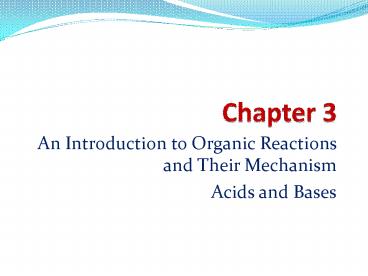An Introduction to Organic Reactions and Their Mechanism - PowerPoint PPT Presentation
1 / 27
Title:
An Introduction to Organic Reactions and Their Mechanism
Description:
An Introduction to Organic Reactions and Their Mechanism Acids and Bases 3.4 Acid Strength Strong acids: completely ionized or completely dissociated Forward reaction ... – PowerPoint PPT presentation
Number of Views:91
Avg rating:3.0/5.0
Title: An Introduction to Organic Reactions and Their Mechanism
1
Chapter 3
- An Introduction to Organic Reactions and Their
Mechanism - Acids and Bases
2
3.4 Acid Strength
- Strong acids completely ionized or completely
dissociated - Forward reaction is predominated
- Most of HA is dissociated
- Conjugated base is weak and has low attraction
for proton - HA(aq) H2O(l) ? H3O(aq) A-(aq)
3
Acids Strength
- Weak acids partially ionized or dissolved
- Reverse reactions is predominated
- Most of HA is undissociate
- Conjugated base is strong and has high attraction
for proton - HC2H3O4(aq) H2O(l) H3O(aq)
C2H3O4-(aq)
4
Acid Strength
5
3.5 The Strength of Acids and Bases Ka and pKa
- The acidity constant, Ka
- a quantitative measure of the strength of an acid
in solution. - It is known as the equilibrium constant for a
chemical reaction known as dissociation in the
context of acid-base reactions - Larger Ka, stronger the acid
6
Acidity and pKa
- Logarithm scale of Ka with the base of 10
- pKa - log Ka
- The larger pKa, the smaller extent of
dissociation - Weaker acids
7
Relative Strength of selected acids and their
conjugated bases
8
Examples
- An acid (HA) has Ka 10-7, what is its pKa?
- Another acid (HB) has Ka 5, what is its pKa?
- Which is the stronger acid?
9
Predicting the Strength of Bases
- The strength of acids will decide the how weak or
strong its conjugated bases - Stronger the acids, the weaker will be its
conjugated base - After losing a proton, acid will become a
conjugated base - When a base accepts a proton, the resulting
chemical is called the conjugate acid of that
original base
10
Acid and its conjugated base
11
Examples
- The pKa of anilinium ion (C6H5NH3) is equal to
4.6. On the basis of this fact, decide whether
aniline (C6H5NH2) is a stronger or weak base than
methylamine
12
3.6 Predicting the Outcome of Acid-Base Reactions
- Acid-base reactions always favor the formation of
the weaker acid and weaker base - Equilibrium favor the formation of the most
stable (lowest potential energy) species - Stronger acid stronger base ? weaker base
weaker acid
13
Example
- Consider the mixing of an aqueous solution of
acetic acid, CH3CO2H (see Table 3.1), and NaOH.
What acid base reaction, if any would take place - H2SO4(aq) NH3(aq) ? NH4(aq) HSO4-(aq)
14
3.6 Water Solubility as the Result of Salt
Formation
- Recall Longer chain of carbon (4 or more) will
be less soluble - Higher molecular weight of carboxylic compounds
do not dissolve in water - Instead, they dissolved in a strong base to form
a water-soluble salt
15
Water Solubility
- We can predict that an amine will react with
aqueous hydrochloric acid
16
Water Solubility
- Methylamine and most amines of low molecular
weight are very soluble in water - Formed a water-soluble salt from hydrochloric acid
17
3.7 Relationships between structure and Acidity
- The strength of a Bronsted-Lowry acid depends on
the extend to which a proton can be separated
from it and transferred to a base. - Removing H ? breaking a bond
- Making the conjugated base more electronegative
- Accepting H ? forming a bond
- Making the conjugated acid less electronegative
18
3.7 Relationships between structure and Acidity
- Bond strength to proton decreases as we move down
to column - Decreasing effectiveness of orbital overlap
between the hydrogen 1s orbital and the orbitals
of successively larger element in the column - Less effective the orbital overlap, the weaker
bond, stronger acid - Acidity increases from left to right
19
3.7 Relationships between structure and Acidity
20
3.7 Relationships between structure and Acidity
21
3.7 The Effect of Hybridization
22
3.7 The Effect of Hybridization
- Electrons of 2s orbtials have lower energy than
those of 2p orbitals because these electrons are
much closer to the nucleus - Having more s orbitals means that electrons of
the anion will be lower in energy and more stable
23
3.7 The Effect of Hybridization
- sp C sH hybridization
- Contain 50 s character
- 1s 1p
- More electronegative spC
24
3.7 The Effect of Hybridization
- sp2C sH hybridization
- Contains 33.3 s character
- 1s 2p
- Less electronegative than spC
25
3.7 The Effect of Hybridization
- sp3C-sH hybridization
- Contains 25 s character
- 1s 3p
- Least electronegative C
26
3.7 The Effect of Hybridization
27
3.7 The Effect of Hybridization
- Relative basicity of the carbanions
- Ethynide ion is the weakest base
- The more electronegative carbon, the more stable
the anion

